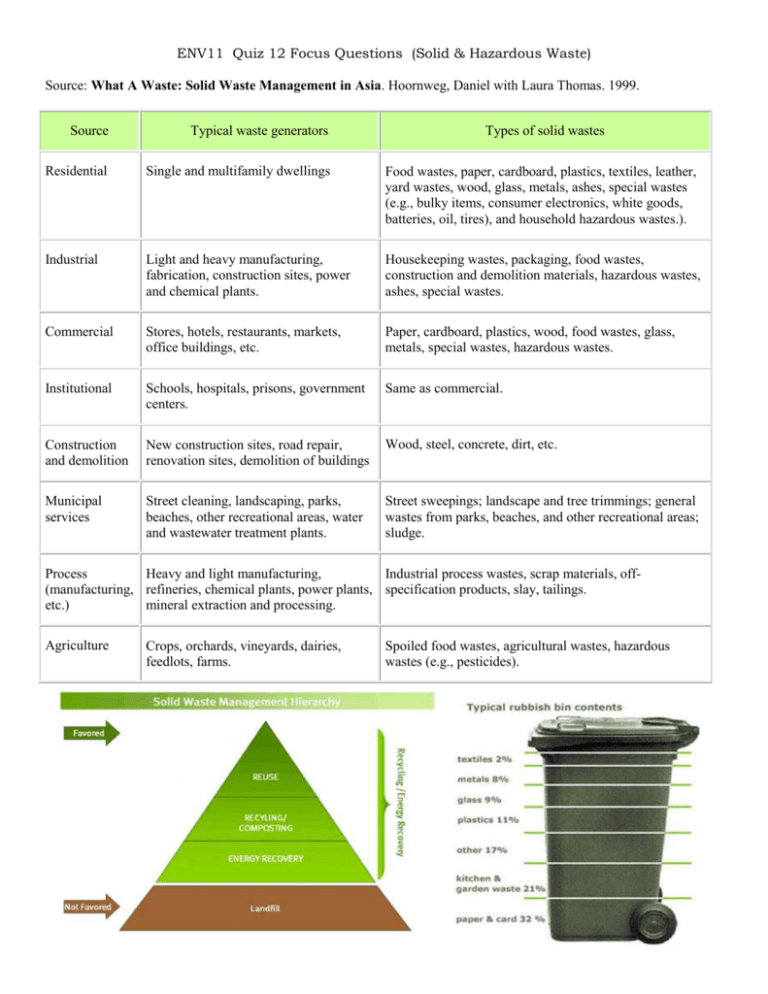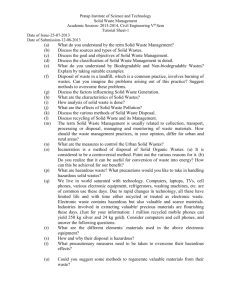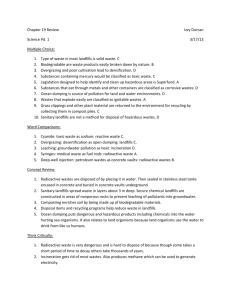Solid & Hazardous Waste
advertisement

ENV11 Quiz 12 Focus Questions (Solid & Hazardous Waste) Source: What A Waste: Solid Waste Management in Asia. Hoornweg, Daniel with Laura Thomas. 1999. Source Typical waste generators Types of solid wastes Residential Single and multifamily dwellings Food wastes, paper, cardboard, plastics, textiles, leather, yard wastes, wood, glass, metals, ashes, special wastes (e.g., bulky items, consumer electronics, white goods, batteries, oil, tires), and household hazardous wastes.). Industrial Light and heavy manufacturing, fabrication, construction sites, power and chemical plants. Housekeeping wastes, packaging, food wastes, construction and demolition materials, hazardous wastes, ashes, special wastes. Commercial Stores, hotels, restaurants, markets, office buildings, etc. Paper, cardboard, plastics, wood, food wastes, glass, metals, special wastes, hazardous wastes. Institutional Schools, hospitals, prisons, government centers. Same as commercial. Construction and demolition New construction sites, road repair, renovation sites, demolition of buildings Wood, steel, concrete, dirt, etc. Municipal services Street cleaning, landscaping, parks, beaches, other recreational areas, water and wastewater treatment plants. Street sweepings; landscape and tree trimmings; general wastes from parks, beaches, and other recreational areas; sludge. Process Heavy and light manufacturing, Industrial process wastes, scrap materials, off(manufacturing, refineries, chemical plants, power plants, specification products, slay, tailings. etc.) mineral extraction and processing. Agriculture Crops, orchards, vineyards, dairies, feedlots, farms. Spoiled food wastes, agricultural wastes, hazardous wastes (e.g., pesticides). Americans generate trash at an astonishing rate of 4.6 pounds (2.1 kilograms) per day per person, which translates to 251 million tons (228 million metric tons) per year [source: EPA]. This is almost twice as much trash per person as most other major countries. What happens to this trash? Some gets recycled or recovered and some is burned, but the majority is buried in landfills. In this article, we will examine how a landfill is made, what happens to the trash in landfills, what problems are associated with a landfill and how these problems are solved. Open dumps : An uncovered site used for disposal of waste without environmental controls. Landfills: Are carefully designed structure built into or on top of the ground in which trash is isolated from the surrounding environment (groundwater, air, rain). This isolation is accomplished with a bottom liner and daily covering of soil. How does a landfill work? http://techalive.mtu.edu/meec/module15/Landfills.htm All landfills will eventually fail and leak leachate into ground and surface water. Plastics are not inert. State-of-the-art plastic (HDPE) landfill liners (1/10 inch or 100 mils thick) and plastic pipes allow chemicals and gases to pass through their membranes, become brittle, swell, and breakdown. "...82% of surveyed landfill cells had leaks while 41% had a leak area of more than 1 square feet," according to Leak Location Services, Inc. (LLSI) website (March 15, 2000). ………………………………………………………… Exporting of waste: The guiding principles of waste management, Reduce, Reuse and Recycle, have been adopted by most countries as an eco-friendly means of waste reduction. Unfortunately the practice of hazardous waste export is increasingly being employed to solve the developed world’s waste problems. While most consumers attempt to put the 3 Rs into practice, many are not aware that unregulated recycling can add to the environmental cost of hazardous waste export. Toxic Tech: Not in our Backyard by Madeleine Cobbing, published by Greenpeace in February 2008 states, “The major issue for both the US and the EU to address is that e-waste is currently exported to less industrialized countries such as China and India, where recycling and recovery takes place with little regard for the human health or environmental consequences”. Incineration: is a waste treatment technology that involves the combustion of organic materials and/or substances. Incineration and other high temperature waste treatment systems are described as "thermal treatment". Incineration of waste materials converts the waste into incinerator bottom ash, flue gases, particulates, and heat, which can in turn be used to generate electric power. The flue gases are cleaned of pollutants before they are dispersed in the atmosphere. Incineration with energy recovery is one of several waste-to-energy (WtE) technologies such as gasification, , pyrolysis and anaerobic digestion. Incineration may also be implemented without energy and materials recovery. In several countries there are still expert and local community concerns about the environmental impact of incinerators. In some countries, incinerators built just a few decades ago often did not include a materials separation to remove hazardous, bulky or recyclable materials before combustion. These facilities tended to risk the health of the plant workers and the local environment due to inadequate levels of gas cleaning and combustion process control. Most of these facilities did not generate electricity. Approximately 85% of volume can be reduced. Be familiar with the advantages and disadvantages of the waste disposal methods in above. This guide attempts to cover everything an informed consumer should know about commonly recycled materials, in plain no-nonsense terms. http://www.obviously.com/recycle/guides/common.html Other things you can do Favor products with a high recycled content, even if they cost a little more. Reduce the volume of packaging you buy, reuse what you can, and recycle the rest. Tell the clerk "I don't need a bag". Use your own reusable canvas bag or backpack at the store. Buy quality products and keep them for a lifetime.!!!!!!!!!!!!!!!!!!!!!!!!!!!!!!!!!!!!!!!!!!!!!!!!!!!!!!!!!!!!!!!!!!!!!!!!!!!!!!!!! Be familiar with the characteristics a waste must have in order for it to be considered for recycling. Be familiar with the characteristics a waste must have to be considered hazardous. Bioremediation , Phytoremediation (Lab) See Handout with hazardous waste management, RCRA, CERCLA, cradle-to-grave, ………








